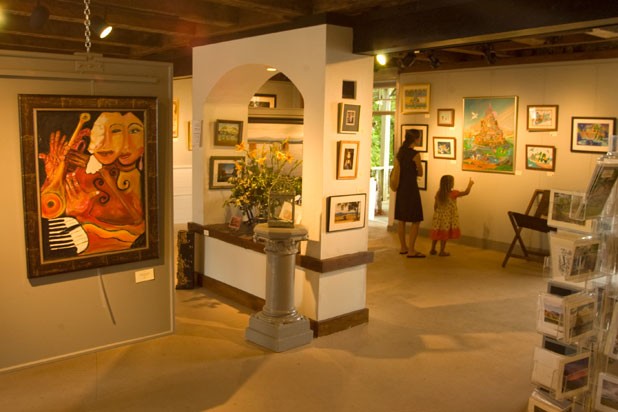
- Matthew Thorsen
The view from the Adirondack Art Association Gallery in downtown Essex, N.Y., may be reason enough to hop on the Charlotte ferry and cross Lake Champlain this summer. The historic firehouse building hugs the shoreline, so, when both doors to the back patio are flung open, all you can see is water.
Oh, and the art’s not too shabby, either.
During the association’s recent “Explosion of Color” group show, the 1000-square-foot gallery was filled to the brim with everything from oil paintings of resplendent mountain views to earth-toned pottery to handpainted dolls.
The association was started in the early 1960s by six local artists, including cartoonist Sid Couchey (see review this issue), noted for his work on Harvey Comics such as Richie Rich in the ’50s through ’80s.
The AAA “started very informally,” says current board chair Gina Schwizer. “Some of the founding members, Patricia Reynolds, Ruth Rumney and Florence Winn, who are still showing with us, were there in Sid’s basement or living room at that first meeting.”
Since then, the nonprofit organization has grown to include roughly 50 exhibiting members who live — for at least a few months of the year — in Essex, Clinton, Warren or Hamilton counties. The association doesn’t jury the artists who show in the gallery, or specify how much of the year they must spend in the Adirondack region. As a result, the gallery, open from May to October, is a unique blend of local and nonlocal art.
“We try to make certain [the artists] have a connection to the area,” says Jim Friday, a board member and contributing photographer, who spends his winters in Rochester, N.Y. He came to Essex because of his wife, whose family has farmed locally for generations. Smitten by the dramatic landscape of his adopted summer home, Friday captures panoramic views of the Adirondacks and Green Mountains to display at the gallery. Other AAA artists, such as Cameron A. Myler, contribute decidedly urban tableaux.
This artistic influence from beyond the Champlain Valley has enriched the local scene, Schwizer says.
“We have a lot of younger members who are starting to show more often with us,” she says. “Younger people, who live here year ’round, are really kind of confined to seeing what’s available to them here. But there’s this influx of artists who come in with different styles and different backgrounds. I think it exposes them to things they wouldn’t see otherwise.”
Likewise, when those part-time Essex artists return to their studios and galleries in New York or Chicago, they take with them a little piece of the North Country, Schwizer surmises.
Friday says it would be hard to pinpoint an “Adirondack style” on display at the gallery, but it’s also impossible to ignore the influence of the region’s landscape on the artwork.
“It’s hard not to be influenced by the light, the mountains,” Friday says.
A large acrylic painting by William Amadon, called “Piseco Lake,” offers viewers the glory of cresting a rocky overlook — and gaining a breathtaking view of the water, nearly white in the glare of the sun — without having to break a sweat. Duker Bower’s oil painting “Gore Road” depicts a slightly grizzled man with a chainsaw taking a breather by a stack of lumber, a black dog in the snow at his feet. And Ellen Few Anderson’s tall, narrow abstract paintings evoke the layers of color in Lake Champlain in early spring: pink bleeding into dark blue bleeding into turquoise and gray.
On the shaded back deck, where a cool breeze blows off the lake, stands Sally J. Smith’s whimsical “Faerie Castle.” The structure, about 4 feet tall, is made primarily of tree bark and pine cones, a delicate fungi staircase circling each tower. Next to the castle, Wendy Miller’s ceramic bowls, plates and mugs are arranged on a table, as if awaiting an afternoon tea. Now through August, the gallery features Couchey’s illustrations of Lake Champlain’s elusive monster in a show called “A ‘Champ’ for the Summer.”
The AAA offers workshops for artists of all ages throughout the summer. “In a small town, there often aren’t a lot of places to gather,” Friday says. “We try to bring people together.”
Essex is definitely a small town, with roughly 800 residents in the summer and 713 year-round, according to the 2000 U.S. Census — though it was once a thriving hub for the shipbuilding industry. Friday says the Lake Champlain port was part of the expressway between New York City and Montréal, until that economy collapsed when railroads began to wind through the region in the mid-19th century.
In conjunction with a visit to the gallery, Friday recommends a stop at the town’s historical society, just a short walk up the road in a renovated former schoolhouse. The Essex Community Heritage Organization has a cool display of faded photographs, salvaged remnants of shipwrecks and the architectural plan for an over-the-top lakeside resort that was never built. Visitors can learn about the history of the area and take in some earlier depictions of the lake and Adirondacks, which have captivated artists for as long as anyone in the little town can remember.









Comments
Showing 1-1 of 1
Comments are closed.
From 2014-2020, Seven Days allowed readers to comment on all stories posted on our website. While we've appreciated the suggestions and insights, right now Seven Days is prioritizing our core mission — producing high-quality, responsible local journalism — over moderating online debates between readers.
To criticize, correct or praise our reporting, please send us a letter to the editor or send us a tip. We’ll check it out and report the results.
Online comments may return when we have better tech tools for managing them. Thanks for reading.